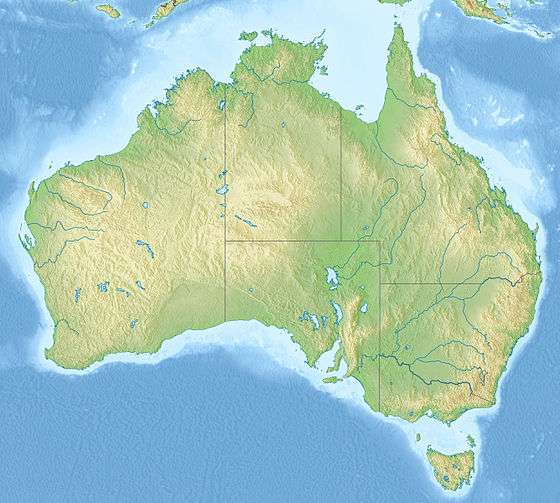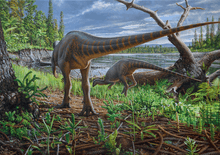Eumeralla Formation
The Eumeralla Formation is a geological formation in Victoria, Australia whose strata date back to the Early Cretaceous. It is Aptian to Albian in age. Dinosaur remains are among the fossils that have been recovered from the formation, particularly from the Dinosaur Cove locality[1] It is partially equivalent to the Wonthaggi Formation.
| Eumeralla Formation Stratigraphic range: Aptian–Albian | |
|---|---|
| Type | Geological formation |
| Unit of | Otway Group |
| Sub-units | Windermere Sandstone Member, Heathfield Sandstone Member |
| Underlies | Sherbrook Group |
| Overlies | Katnook Sandstone, Laira Formation (Crayfish Subgroup) |
| Thickness | Up to 3,000 m (9,800 ft) |
| Lithology | |
| Primary | Volcanilithic sandstone, siltstone, mudstone, conglomerate |
| Location | |
| Coordinates | 38.8°S 143.3°E |
| Approximate paleocoordinates | 74.8°S 115.8°E |
| Region | |
| Country | |
| Extent | Otway Basin |
 Eumeralla Formation (Australia) | |
Dinosaurs

Indeterminate dinosaur tracks named as Skolithos sp. and Arenicolites sp.,[3] as well as indeterminate ornithischian tracks are present in Victoria, Australia.[1] Indeterminate euornithopod remains are present in Victoria, Australia.[1] Indeterminate theropod, ornithomimosaur, and possible indeterminate oviraptorosaur and dromaeosaurid remains are present in Victoria, Australia.[1]
| Dinosaurs of the Eumeralla Formation | ||||
|---|---|---|---|---|
| Genus | Species | Presence | Notes | Images |
|
A. loadsi[1] |
Geographically present in Victoria, Australia.[1] |
"Maxilla [and] teeth."[4] |
| |
|
D. pickeringi[5] |
Geographically present in Victoria, Australia.[5] |
Partial poscranial skeleton.[5] | ||
|
L. amicagraphica[1] |
Geographically present in Victoria, Australia.[1] |
"Skull fragments teeth, [and] isolated postcrania."[6] | ||
|
T. hermani[1] |
Geographically present in Victoria, Australia.[1] |
Later determined to be indeterminate ornithomimmosaur remains.[1] "Tibiae [and] vertebrae."[7] | ||
|
No formal name. |
Possibly from a species also found at the Wonthaggi Formation (single furcula). |
Footprints belonging to a crane-sized bird, determined to be an ornithurine or enantiornithe. | ||
|
Megaraptora indet.[9] |
No formal name |
Known from a hand. |
Related to the South American Megaraptor. | |
|
?Spinosauridae indet.[10][11] |
No formal name |
Known from a single cervical vertebra. |
Possibly indeterminate megaraptoran remains | |
| Ankylosauria indet.[12] | No formal name | Dinosaur Cove | Dorsal vertebra | |
| Other taxa of the Eumeralla Formation | ||||
|---|---|---|---|---|
| Genus | Species | Presence | Notes | Images |
| Ceratodus | C. nargun | A lungfish | ||
| Kryoryctes | K. cadburyi | Dinosaur Cove | A monotreme | |
| Otwayemys | O. cunicularius | Dinosaur Cove | A meiolaniform turtle | |
| Pterosauria | Indeterminate | Dinosaur Cove | ||
| Plesiosauria | Indeterminate | Dinosaur Cove | ||
See also
- List of dinosaur-bearing rock formations
- South Polar region of the Cretaceous
References
- Weishampel, David B; et al. (2004). "Dinosaur distribution (Early Cretaceous, Australasia)." In: Weishampel, David B.; Dodson, Peter; and Osmólska, Halszka (eds.): The Dinosauria, 2nd, Berkeley: University of California Press. Pp. 573-574. ISBN 0-520-24209-2.
- "Dinosaur Cove, Australia". This Dynamic Earth. USGS. Retrieved 14 March 2015.
- Milanesia Beach tracksite at Fossilworks.org
- "Table 18.1," in Weishampel, et al. (2004). Page 394.
- Herne, M. C.; Tait, A. M.; Weisbecker, V.; Hall, M.; Nair, J. P.; Cleeland, M.; Salisbury, S. W. (2018-01-11). "A new small-bodied ornithopod (Dinosauria, Ornithischia) from a deep, high-energy Early Cretaceous river of the Australian–Antarctic rift system". PeerJ. 5: e4113. doi:10.7717/peerj.4113. PMC 5767335. PMID 29340228.
- "Table 18.1," in Weishampel, et al. (2004). Page 395.
- "Table 6.1," in Weishampel, et al. (2004). Page 139.
- Martin, Anthony J.; Vickers-Rich, Patricia; Rich, Thomas H.; Hall, Michael (2013). "Oldest known avian footprints from Australia: Eumeralla Formation (Albian), Dinosaur Cove, Victoria". Palaeontology. 57: 7–19. doi:10.1111/pala.12082.
- Owen, James. "New Dinosaur May Link S. American, Aussie Dinos". National Geographic News. Retrieved July 12, 2016.
- Barrett, Paul (June 21, 2011). "First spinosaurid from Australia and the cosmopolitanism of Cretaceous dinosaur faunas". Biology Letters. 7 (6): 933–936. doi:10.1098/rsbl.2011.0466. PMC 3210678. PMID 21693488.
- Arden, T. M. S.; Klein, C. G.; Zouhri, S.; Longrich, N. R. (2018). "Aquatic adaptation in the skull of carnivorous dinosaurs (Theropoda: Spinosauridae) and the evolution of aquatic habits in Spinosaurids". Cretaceous Research. 93: 275–284. doi:10.1016/j.cretres.2018.06.013.
- Barrett, Paul M.; Rich, Thomas H.; Vickers-Rich, Patricia; Tumanova, Tat'yana A.; Inglis, Matthew; Pickering, David; Kool, Lesley; Kear, Benjamin P. (September 2010). "Ankylosaurian dinosaur remains from the Lower Cretaceous of southeastern Australia". Alcheringa: An Australasian Journal of Palaeontology. 34 (3): 205–217. doi:10.1080/03115511003655430. ISSN 0311-5518.

